The Truth About Liquidity: 2024 Exchange Coin Listing Effect Research Report
This study aims to explore the listing status on major exchanges and analyze its actual impact on token market performance, with a focus on post-listing changes in trading volume and price volatility characteristics.
Original Title: "The Truth About Liquidity: A Study of Listing Effect on 2024 Exchanges"
Original Source: Klein Labs
1. Research Introduction
1.1 Research Background
Throughout this year, there has been extensive discussion in the market regarding VC tokens with high Fully Diluted Valuation (FDV) but low Market Capitalization (MC). With the tokens issued in 2024, the MC/FDV ratio has dropped to the lowest level in the past three years, indicating a significant amount of tokens will unlock and enter the market in the future. Despite the initially low circulating supply, the market may experience price increases in the short term due to increased demand, but this surge lacks sustainability. Once a large number of tokens unlock and enter the market, the risk of oversupply intensifies, and investors begin to worry that this market structure may not provide sustained support for price increase.
Therefore, many investors have started to shift their interest from these VC tokens to Meme coins. Meme coins are characterized by the majority of tokens being fully unlocked at TGE, having a higher circulation rate, and lacking sell pressure from future unlocks. This structure reduces supply pressure in the market, giving investors more confidence. Many Meme coins have an MC/FDV ratio close to 1 at issuance, meaning holders will not face dilution from further token issuance, providing a relatively stable market environment. As awareness of the risk of massive token unlocks deepens, investors are gradually turning to these Meme coins with higher liquidity and lower inflation rates, even though these tokens may lack practical use cases.
In the current market landscape, investors are required to be more cautious in selecting tokens. However, investors often find it challenging to independently assess the value and potential of each project when picking tokens, making the screening mechanism of exchanges crucial. As the "gatekeepers" who directly introduce token assets to users, centralized exchanges not only help validate the compliance and market potential of tokens but also play a role in screening high-quality projects. Despite another viewpoint in the market that on-chain trading will surpass CEX trading, Klein Labs believes that the market share of centralized exchanges will not be overtaken by on-chain trading. Factors such as the smoothness of CEX trading, centralized and accountable asset custody, user habits and mindset development, liquidity barriers, and the global regulatory compliance trend make the trading share within CEXes surpass on-chain trading share in the long term.
So, the question arises: How do centralized exchanges filter and decide to list among numerous projects? How has the overall performance been of the tokens listed in the past year? Is there a correlation between the performance of these listed tokens and the chosen exchange?
To address these market concerns, this study aims to explore the listing status of major exchanges and analyze their actual impact on token market performance, focusing on changes in trading volume and price volatility after listing to identify how different exchanges influence the market performance of newly listed tokens.
1.2 Research Method
1.2.1 Research Subjects
We categorize exchanges based on their region and target market into three main types:
· Chinese-founded, global-facing: Binance, Bybit, OKX, Bitget, KuCoin, Gate, etc. These are well-known exchanges founded by Chinese individuals targeting the global market. As there are many Chinese exchanges, for research purposes, we have selected exchanges with different development characteristics. Exchanges not selected also have their respective advantages.
· Korean-founded, domestic-facing: Bithumb, etc. These primarily target the South Korean domestic market.
· US-founded, Europe- and US-facing: Coinbase, Kraken, etc. These are U.S.-based exchanges mainly catering to the European and U.S. markets and are usually subject to strict regulations such as the SEC and CFTC.
Exchanges in other regions such as Latin America, India, Africa, etc., have an overall trading volume and liquidity of less than 5% and are therefore not deeply analyzed in this research report.
We have selected a total of 10 representative exchanges mentioned above to analyze their listing performance, including the number of listing events and their subsequent market impact.
1.2.2 Timeframe
We primarily focus on the price changes on the 1st day, 7th day, and 30th day after the token generation event (TGE) to analyze the trends, volatility patterns, and market reactions for the following reasons:
· On the first day of the TGE, new asset issuance results in highly active trading volume, reflecting the market's immediate acceptance. Influenced significantly by fundraising and FOMO sentiment, this is a critical stage for the initial market pricing.
· Price changes in the first 7 days after TGE can capture the market's short-term sentiment towards the new token, initial recognition of the project's fundamentals, measure the sustainability of market enthusiasm, and return to a reasonable initial project pricing.
· First 30 Days After TGE observe the token's long-term support, cool down of short-term speculation, gradual exit of speculators, and whether the token price and trading volume are maintained, becoming an important reference for market acceptance.
1.2.3 Data Processing
This study adopts a systematic data processing method to ensure the scientific analysis. Compared to common research methods in the market, this study is more intuitive, concise, and efficient.
In this research report, the data mainly comes from TradingView, covering price data of tokens newly listed on major exchanges in 2024, including initial listing price, market prices at different time points, and trading volume data. Due to the large number of sample points, this large-scale data analysis helps reduce the impact of individual outlier data on the overall trend, thereby improving the reliability of the statistical results.
(I)Multivariable Overview of Listing Activity
This study adopts a multivariable analysis method, comprehensively considering market trends, trading depth, liquidity, and other factors to ensure the comprehensiveness and scientific nature of the results. We compared the average price changes of new coins on different exchanges and conducted in-depth analysis combined with the exchanges' market positioning (such as user base, liquidity, listing strategy).
(II)Mean Value Assessment of Overall Performance
To measure the token's market performance, we calculated its percentage change relative to the initial listing price, with the calculation formula as follows:

Considering that extreme situations in the market may affect the overall data trend, we excluded the top 10% and bottom 10% of extreme outliers to reduce the interference of incidental market events (such as sudden positive news, market manipulation, liquidity anomalies) on the statistical results. This processing method makes the calculation results more representative, accurately reflecting the real market performance of new coins on different exchanges. Subsequently, we calculated the average price change of new coins on each exchange to measure the overall performance of new coins on different platforms.
(III)Coefficient of Variation for Stability Assessment
The coefficient of variation (CV) is an indicator that measures the relative variability of data, with the calculation formula as:

Where σ is the standard deviation and μ is the mean. The coefficient of variation is a dimensionless measure that is not influenced by data units, making it suitable for comparing the volatility of different datasets. In market analysis, CV is mainly used to measure the relative volatility of prices or returns. In a trading platform or token price analysis, CV can reflect the relative stability of different markets, providing investors with a basis for risk assessment. Here, we use the coefficient of variation instead of the standard deviation because the coefficient of variation is more applicable compared to the standard deviation.
2. Listing Event Overview
2.1 Comparison Between Trading Platforms
2.1.1 Listing Quantity and FDV Preference
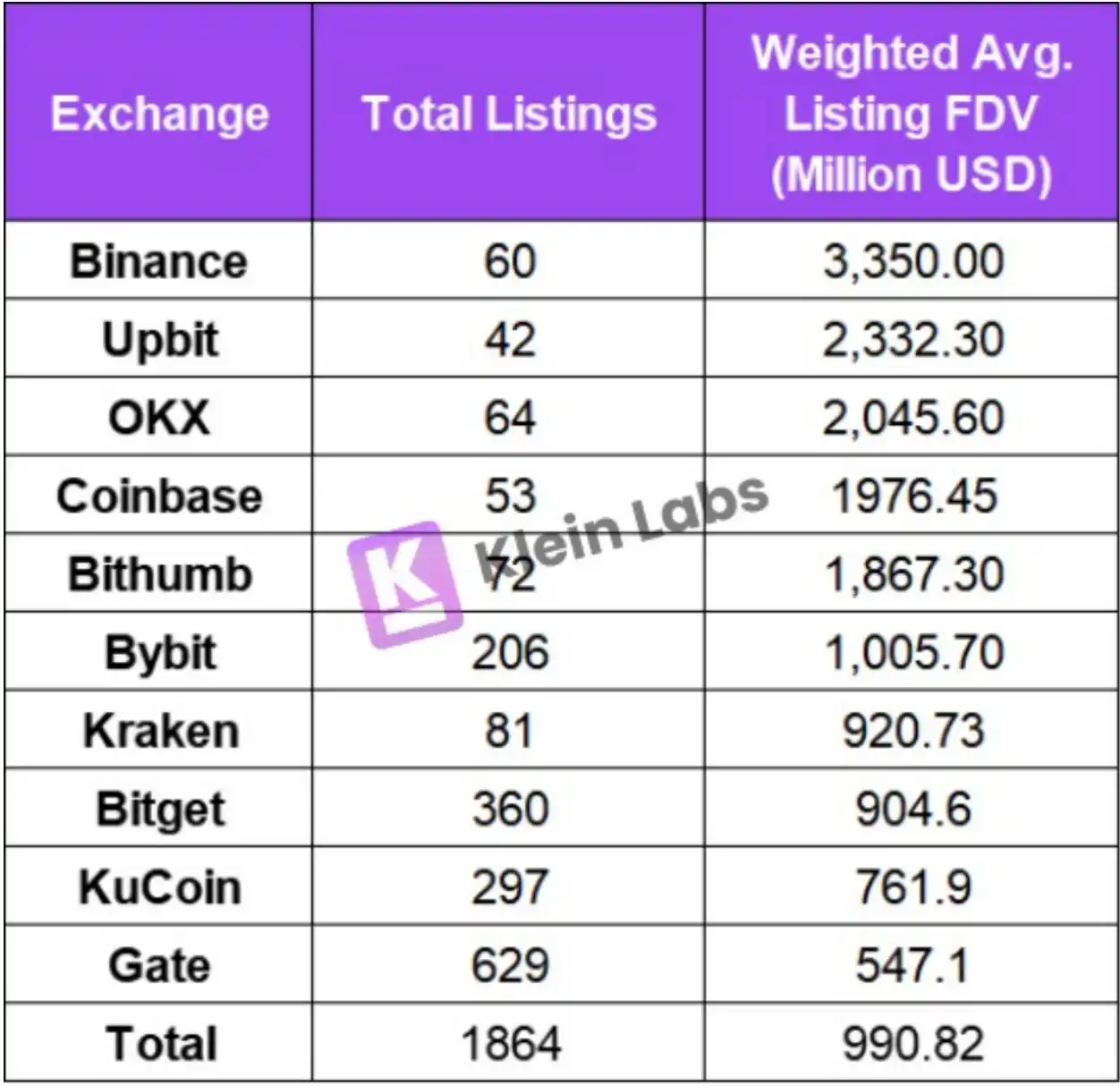
2024 Listing Event Overview
We found that: Overall, the top-tier trading platforms (such as Binance, Coinbase) generally have fewer listing events than other trading platforms. This reflects the different influence of the exchange's status on the listing style.
In terms of listing quantity, exchanges such as Binance, OKX, Coinbase have stricter listing rules, resulting in fewer listings but on a larger scale. On the other hand, exchanges like Gate list new assets more frequently, providing more trading opportunities. The data shows that listing quantity and FDV are negatively correlated, meaning that exchanges listing more high FDV projects tend to have fewer listing events.
CEXs adopt different strategies to determine listing priorities, focusing on different Fully Diluted Valuation (FDV) tiers. Here, we classify projects based on different FDV levels to better understand the listing criteria of trading platforms. When evaluating token valuation, we often consider Market Cap (MC) and FDV, both of which reflect the token's valuation, market size, and liquidity.
· MC only calculates the total value of currently circulating tokens and does not consider tokens that will unlock in the future, which may underestimate the true valuation of the project. This can be especially misleading when most tokens are still locked.
· FDV, on the other hand, is based on the total token supply, providing a more comprehensive reflection of the project's potential valuation, helping investors assess future selling pressure risks and long-term value. For projects with low MC/FDV, the short-term significance of FDV is limited, and it serves more as a long-term reference.
Therefore, when analyzing newly listed tokens, FDV is more referential than Market Cap. Here, we choose FDV as the standard.
In addition, in terms of the attitude towards initial projects, most trading platforms usually adopt a balanced strategy, considering both initial and non-initial projects. However, the requirements for non-initial projects are usually higher because initial projects bring in more new users. Additionally, two South Korean trading platforms, such as Bithumb, mainly focus on listing non-initial projects. This is because compared to initial projects, listing non-initial projects can reduce screening risks, avoid market fluctuations during the initial stage, and mitigate early liquidity issues. At the same time, for project teams, listing non-initially requires less market promotion and liquidity management pressure compared to initial listing. Listing non-initially can leverage existing market recognition to drive growth.
2.1.2 Race Preference
Binance
In 2024, the number of meme coins still accounts for the highest proportion. Infrastructure and DeFi projects have a significant share. The RWA and DePIN tracks have relatively fewer listings on Binance, but they perform well overall. The USUAL spot saw the highest increase of up to 7081%. Although Binance is cautious in its listing choices in these areas, once listed, the market response is usually positive. In the second half of the year, Binance's listing preference in the AI track is notably inclined towards AI Agent tokens, with the highest proportion in AI projects.
In 2024, Binance tends to favor the BNB ecosystem. For example, projects like BANANA and CGPT being listed indicate Binance's strengthening support for its native chain ecosystem.
OKX
Looking at the number of listings on OKX, meme coins also account for the highest proportion, at around 25%. However, compared to other trading platforms, there are more listings in the public chain and infrastructure tracks, accounting for a total of 34%. This suggests that OKX in 2024 is more focused on underlying technological innovation, scalability optimization, and the sustainable development of the blockchain ecosystem.
In emerging tracks, OKX has only listed 4 AI tokens, including DMAIL and GPT, launched 3 new tokens in the RWA track, and only 3 in the DePIN track. This reflects the cautious layout of OKX in relatively emerging tracks.
The biggest feature of listings in 2024 is a wide coverage of tracks, with tokens generally performing well. In 2024, UNI and BNT were listed on the DEX track. This indicates that there is still significant potential and room for development in listing popular assets; many mainstream or high market value tokens have yet to be listed and may further expand support in the future. At the same time, this also reflects a strict listing review process, leaning towards carefully selecting assets with long-term potential.
Above, the tokens from various tracks have shown significant price increases. Tokens from tracks such as PEPE (Meme), AGLD (Game), DRIFT (DeFi), SAFE (Infra), etc., have seen notable price surges in the short term, with gains of up to 100% and even exceeding 150%. UNI saw a price increase of 93.5% compared to its first day after listing on the 30th day. This reflects the high level of recognition Korean users have for projects upon listing.
Furthermore, from the perspective of public chain ecosystems, ecosystems such as Solana and TON have been favored.
We have also observed that exchanges are gradually deepening their support for their own blockchain ecosystems. For example, Binance's associated BSC and opBNB chain have seen a continuous strengthening of support for their on-chain ecosystem. Similarly, Coinbase's launched Base has become a key focus for them, with Base projects accounting for nearly 40% of all newly listed coins in 2024. Additionally, OKX continues to make efforts in the X Layer ecosystem. Moreover, the planned launch of Kraken's L2 network, Ink, further demonstrates that leading exchanges are actively promoting on-chain infrastructure development.
Behind this trend is the exploration of exchanges transitioning from "off-chain" to "on-chain," expanding not only their business scope but also strengthening their competitiveness in the DeFi space. By supporting projects on their own chain, exchanges can drive ecosystem development, enhance user stickiness, and earn higher rewards in the process of issuing and trading new assets. This also indicates that in the future, exchanges' listing strategies will lean towards projects within their own ecosystem to enhance the activity and market influence of their blockchain networks.
2.2 Time Dimension Analysis
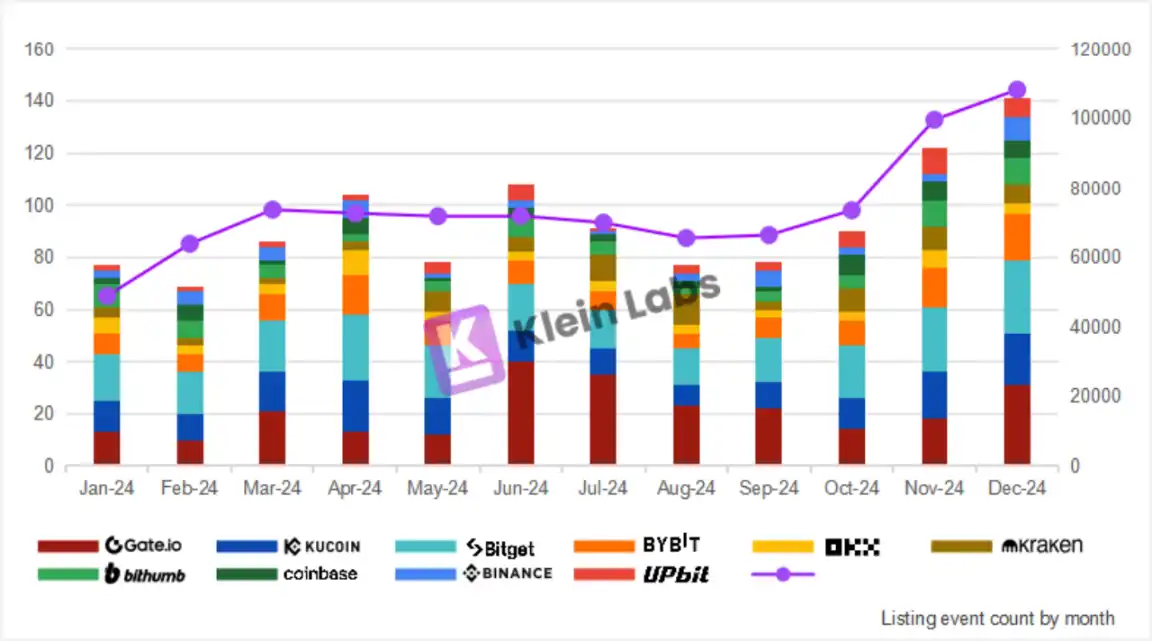
Number of listings per month on different exchanges
· The increase or decrease trend in listing events aligns with the rise and fall of BTC prices. During BTC's upward trends (February to March and August to December), there were more listing events, while during BTC's sideways or downward movements (April to July), the number of listing events significantly decreased.
· Top-tier exchanges (such as Binance) were less affected by bear markets in terms of listing activities, with their listing shares even expanding during this period, demonstrating stronger market leadership and countercyclical capabilities.
· The number of listings on Bitget remains relatively stable, with market fluctuations having a minor impact on it, while the listing pace on other exchanges fluctuates significantly. This may be related to its more balanced listing strategy.
· Gate and KuCoin have a higher listing frequency, but the number of listings fluctuates more with market trends, indicating that these exchanges may rely more on the higher liquidity of new projects during bull markets to attract users.
3. Trading Volume Analysis
3.1 Overall Trading Volume Analysis of Different Exchanges
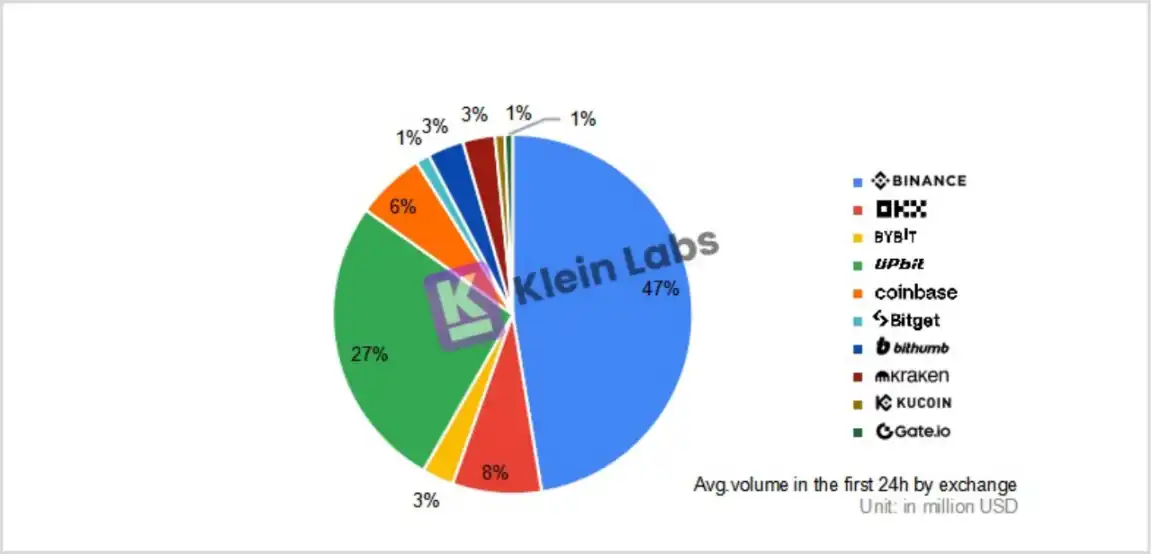
Average trading volume in the first 24 hours after TGE of projects on various exchanges in 2024
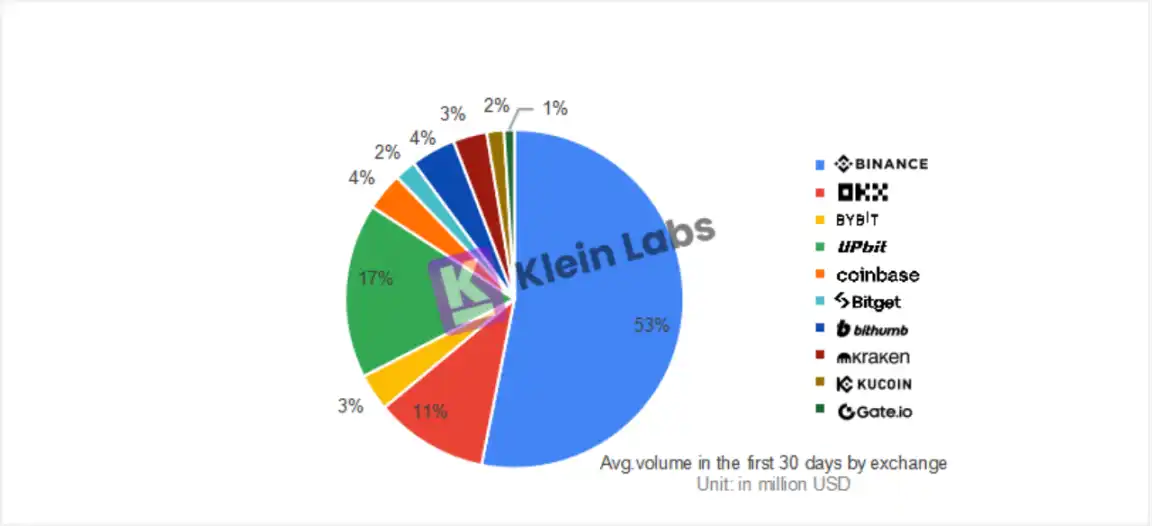
Average trading volume 30 days after TGE of projects on various exchanges in 2024
· The trading volume percentage within 24 hours of listing is extremely high, even exceeding half of Binance's, demonstrating its strong short-term market appeal and significant liquidity influx. Although the percentage decreases slightly after 30 days, it still maintains a high market share, with the percentage even approaching the sum of the market shares of the top three exchanges, OKX, Coinbase, and Bybit, indicating a highly significant position in the listing market.
· Binance and OKX show steady volume growth, with a leading market share after 30 days, demonstrating strong market recognition and liquidity depth. Binance holds a 47% share within 24 hours, increasing to 53% after 30 days, indicating its long-term market dominance, while OKX also maintains a high share after 30 days.
· Bybit performs well in both short-term and long-term trading volumes, remaining relatively stable. Meanwhile, Bithumb's market share slightly rises after 30 days, indicating its ability not only to retain early trading volume but also to attract more liquidity. This suggests that Bithumb's competitiveness in the listing market has strengthened.
Although Korean exchanges are known for favoring non-primary listings, as the data above shows, these projects can still generate very strong trading volumes. The significant trading volume generated by non-primary listings on Korean exchanges is primarily attributed to their unique market environment:
The Closed Nature and Liquidity Concentration of the South Korean Trading Market
· Market Closure: Due to South Korea's strict domestic KYC policy, overseas users are basically unable to directly use South Korean exchanges. This regional isolation has led to a relatively closed trading ecosystem in the South Korean market, with a large number of domestic users accustomed to trading on South Korean exchanges. Therefore, the internal liquidity of the South Korean market is more concentrated.
· Exchange Platform Monopoly: The South Korean crypto market exhibits a highly monopolistic structure, currently holding 70%-80% of the South Korean crypto market share, firmly established as the industry leader. After establishing its leading position in 2021, Bithumb's former #1 position was overtaken, and its market share dropped to 15%-20%. South Korean trading volume and liquidity are converging towards the top platforms, demonstrating a strong fund aggregation effect.
Therefore, even though a token has already been listed globally, its trading activity in the South Korean market will still show a "first-day listing" effect, driving significant market attention and capital inflows.
The High Holding Rate and Capital Advantage of the South Korean Crypto Market
· High Penetration of Crypto Assets: South Korean investors have an extremely high holding ratio of cryptocurrency, much higher than other major markets. As of November 2024, the number of people holding cryptocurrency on South Korean exchanges exceeded 15.59 million, equivalent to over 30% of the South Korean population. Many Koreans hold a significant amount of cryptocurrency themselves and are more inclined towards digital assets in their investment choices. With 0.6% of the global population, South Korea contributes 30% of global cryptocurrency trading volume.
· Abundant Social Capital: In addition, South Korea is a developed country with a high GDP, and there is abundant social capital and massive investable funds, providing the crypto market with ample liquidity.
· Limited Space for Young People in Traditional Industries: South Korea is a capitalist country dominated by conglomerates, and young people face significant employment and life pressures, with intensified class stratification increasing their desire for wealth appreciation channels. About 3.08 million young people aged 20-39 are involved in cryptocurrency trading, accounting for 23% of the total population in that age group.
As of November 2024, the total amount of cryptocurrency held by South Koreans has risen to 102.6 trillion Korean won (approximately 69.768 billion US dollars), and the daily trading volume has also increased to 14.9 trillion Korean won (approximately 10.132 billion US dollars). In the fourth quarter of 2024, it became the fastest-growing CEX in terms of trading volume, rising from 135.5 billion to 561.9 billion US dollars, a quarter-on-quarter increase of 314.8%. This growth reflects the robust demand in the South Korean market for crypto assets and further confirms the high volume trend of South Korean exchanges in non-primary market projects.
4. Price Performance Analysis
4.1 Price Performance Comparison by Exchange
4.1.1 Overall Price Performance on Each Exchange
Comparison of the Mean and Median Prices on Various Exchanges 7 Days After TGE
· Binance performed the best, with both the mean and median prices standing out. The top three in terms of mean price were Binance, OKX, Bitget, with OKX having a positive mean but a negative median, indicating high price volatility for rising tokens, leading to significant short-term price fluctuations and noticeable outliers. Bitget's performance was quite remarkable, being closest to the two major leading exchanges among the others. Additionally, its median price increase ranked second among all exchanges, just behind Binance, showing a significantly positive value, indicating a strong, upward price trend for tokens on Bitget.
· Among mid-sized exchanges, Bithumb, Gate, and KuCoin showed relatively good performance. Bithumb demonstrated a more balanced price performance, with the smallest difference between the absolute value and the median, suggesting minimal price fluctuations and stable performance. However, KuCoin and Gate had negative median values with relatively high absolute values, indicating lower token success rates and possible interference from numerous abnormal increases.
Comparison of the Mean and Median Prices on Various Exchanges 30 Days After TGE
· By the 30th day, overall median prices had dropped, indicating that, especially for tokens with lower liquidity, a considerable amount of speculative capital had been withdrawn from the market, increasing selling pressure while lacking sufficient buying support, leading to price declines. Gate may have experienced significant market volatility due to a high number of listings, resulting in insufficient liquidity. This suggests that the platform failed to attract adequate stable capital inflows, and the excessive token selection dispersed liquidity, disrupting the balance between buyers and sellers, causing a significant price drop.
· Binance was less affected, with a slight decrease in the mean price, indicating that 30 days after listing, its listed tokens still maintained strong market support and stable trading volume, with some tokens still having room for growth. As a top-tier exchange, Binance, leveraging its extensive market liquidity and broad user base, even when the overall new token market declined after 30 days, its listed token prices could still remain relatively high.
· Among medium-sized exchanges, Bithumb is the only exchange that saw an increase in price after 30 days, with both 7-day price change and median price change being positive. This indicates that Bithumb, with its good market liquidity and stability, successfully attracted funds, showing strong resilience to price drops and market attractiveness. This may be due to Bithumb's relatively small number of listed tokens, allowing it to concentrate liquidity, maintain a strong market activity, and enable newly listed tokens to perform better in terms of price.
4.1.2 Monthly Price Performance of Each Exchange Upon Listing
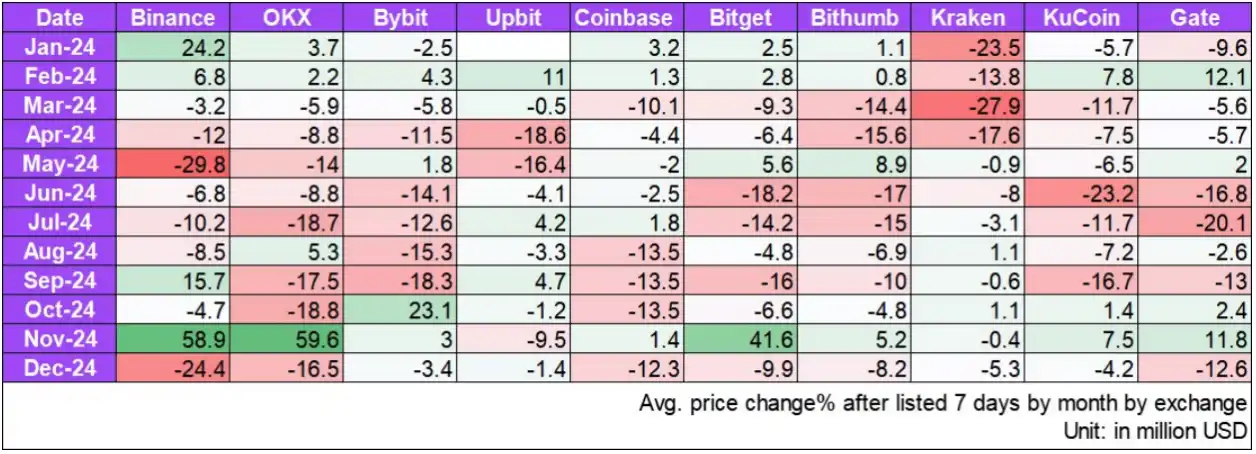
Price change of each exchange one week after TGE, monthly
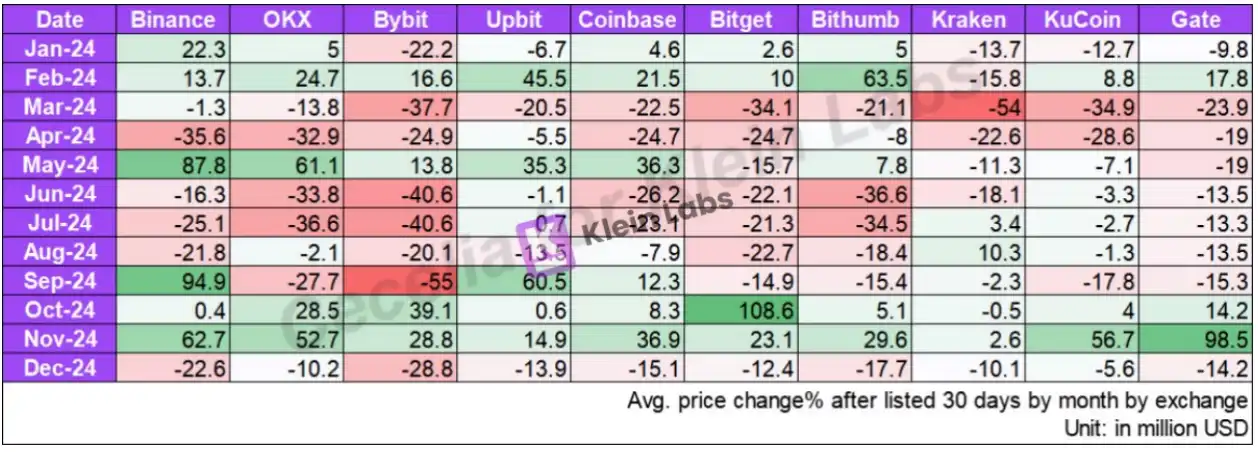
Price change of each exchange 30 days after TGE, monthly
· Binance shows a clear price advantage and is heavily influenced by market sentiment. Binance's listings perform exceptionally well when the market sentiment is positive, for example, in May and September, Binance had 30-day price increases of 87.8% and 94.9%, respectively, and a 60.5% increase in September, demonstrating a strong price advantage. However, it also exhibits high volatility, with significant price declines in April and July, indicating a significant impact of market sentiment on its performance.
· The overall market trend significantly affects token prices, with tokens listed on top exchanges experiencing larger increases during bull markets, while exchanges of medium size are more prone to significant drops during market downturns. For instance, Bybit and OKX had 30-day price drops of -40.6% and -36.6% in July, respectively, while Kraken and KuCoin also showed weaker overall performance after 7 days, especially Kraken, with price drops of -23.5% and -27.9% in January and March, respectively.
4.2 Price Change Volatility
In the previous section, we used the average to reflect the overall price change. Next, we will use the coefficient of variation to reflect the volatility of the sample data around the average price change. A small coefficient of variation indicates that the data distribution is concentrated, with most tokens' price changes close to the average level, showing a stable market performance and a higher predictability of price changes after listing on exchanges; conversely, a higher coefficient of variation indicates that the price trends after listing are more uncertain for exchanges.
Next, the price analysis for 1 day and 30 days:
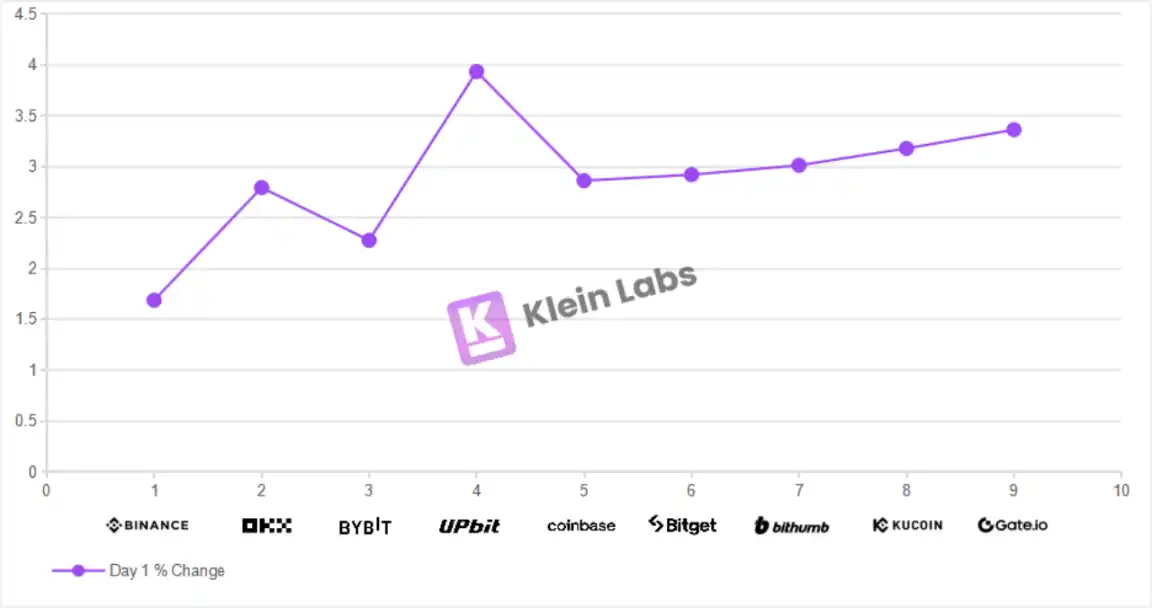
Coefficient of Variation (CV) on Day 1 after TGE
· Binance had the lowest CV, indicating that the price fluctuation of the token listed on its platform on the first day was relatively small, showing the most stable market performance. The highest CV was observed in , indicating a significant price swing on the first day. However, considering the previous average analysis, it is estimated that the market overall is likely to have a general upward trend.
· Medium-sized exchanges (along the axis from left to right) showed a linear increase in CV. From Bitget with the lowest CV to Gate with the highest CV, these exchanges' listing market performance gradually shifted from relatively stable to higher uncertainty, moving from relatively low short-term investment risk to gradually increasing risk.
· Bybit had a relatively low CV, closest to Binance, indicating that its market volatility is also relatively manageable. However, considering Bybit's larger number of listings while maintaining a low CV, it suggests that the overall quality of the projects listed on Bybit is high, with no widespread highly volatile coins. Furthermore, this also reflects that Bybit's listing selection strategy may lean towards tokens with strong stability, thereby reducing sharp market fluctuations in the short term.
Coefficient of Variation (CV) on Day 30 after TGE
· Looking at the CV on Day 30, still maintained a higher CV after 7 days and 30 days, indicating significant price fluctuations of its trading pairs and higher market liquidity. Observing the average values, the trading pairs showed positive averages, and the price decline was relatively slow, indicating active buying and selling, strong liquidity depth, and overall market health. From the perspective of CV, has a significant advantage over other exchanges at this point.
· Binance and Coinbase remained relatively stable exchanges, with Binance showing a stable price increase throughout the cycle, while Coinbase's fluctuation trend stabilized between 7 days and 30 days, indicating that its token market tends towards long-term stable development rather than short-term sharp fluctuations.
· Medium-sized exchanges (such as Bitget, Bithumb, Gate, KuCoin) saw a significant increase in CV on Day 30, indicating a decrease in liquidity after short-term arbitrage funds exited, leading to intensified price fluctuations. The market is still dominated by short-term funds, with a lower proportion of long-term funds, resulting in overall weaker stability. In particular, Bitget has high activity but also carries significant volatility risks.
5. Key Findings Summary
5.1 Data Conclusion
Based on the above research and data, we have the following conclusions:
5.1.1 Trading Platform Listing Decision Significantly Affects Listing Performance
Generally, on exchanges with fewer and more stringent listings, after removing extreme outliers, price performance tends to be better. However, overall Bitcoin trends, regional market conditions, and user characteristics also affect listing performance.
Exchanges with a higher number of listings do show relatively prominent short-term average performance; however, in the long term, a higher number of listings lead to more liquidity dispersion, which may result in a larger pullback after 30 days and lower price stability.
5.1.2 Top-tier Exchanges Tend to Have Greater Price Increases Compared to Mid-tier Exchanges in a Bull Market
Yet, when looking at another indicator, average price increases, major top-tier exchanges have varying performance in terms of 7-day and 30-day price increases, but overall positive. Binance shows the best performance across various price metrics. OKX shows significant volatility in the medium to long term. Top-tier exchanges exhibit the most stable performance, possibly due to greater liquidity depth. In reality, tokens can experience a high price swing on the first day of listing. However, since this study records the closing price of the first day, these outstanding performances may not be captured. Among mid-tier exchanges, Bitget and Bithumb show relatively prominent performance. Bitget exhibits stability, while Bithumb shows outstanding performance in some price metrics.
5.1.3 Advantages of the Korean Market and Listing Effect
The Korean market has a unique market environment with high trading volume and good liquidity. Tokens listed on this market can quickly attract funds, and although there is significant initial price volatility, the overall trend is upward. Price fluctuations remain sharp after 7 days and 30 days, indicating that in the Korean market, token listing can receive a more extended development period and higher visibility.
5.1.4 Impact of Exchange Listing Process on Token Performance and Market Stability
During the data processing, we found that certain exchanges had significantly more outliers, indicating that the token screening and review processes are crucial for post-listing performance. Outliers often reflect tokens deviating from expectations, potentially influenced by market manipulation or project risks. Exchanges with frequent outliers may have a more lenient screening process, allowing unstable tokens to enter the market and increasing price volatility risk. Therefore, an exchange's token screening process directly affects the token's market performance and overall market stability.
5.2 Exchange Performance
5.2.1 Binance & OKX
In various indicators, both have shown outstanding performance, but in the long term, Binance has a stronger advantage in terms of stability. Binance's market performance is relatively stable, able to maintain continuous growth with low volatility. In contrast, although OKX has a larger market volatility compared to Binance, it is almost on par with Binance in multiple indicators.
5.2.2 Bithumb
Bithumb is one of South Korea's two leading cryptocurrency exchanges and has overall outstanding performance. It has consistently maintained a high ranking among global exchanges. As one of the earliest exchanges established in South Korea, Bithumb has performed excellently in some tokens. The high speculation enthusiasm in the Korean market has brought a large amount of capital to local exchanges, resulting in high liquidity and trading volume. Due to the high liquidity depth and the large number of retail investors in Korea, price changes are not too significant on a medium to long-term scale. However, focusing on shorter-term hourly trading, Korean exchange volumes and price fluctuations exceed those of other exchanges at a similar level. Since this study mainly focuses on the price changes of tokens 1 day, 7 days, and 30 days after listing, it may not fully reflect the outstanding performance of Korean exchanges.
It is worth noting that Bithumb has a significant "Kimchi Premium" regional advantage. After some tokens are listed on Korean exchanges, their prices usually surge in the short term compared to other global exchanges, giving Bithumb an advantage that other global exchanges cannot match.
5.2.3 Bybit
As one of the top exchanges, Bybit has strong liquidity depth and rich listing experience, providing a stable trading environment. Although Bybit experienced a significant scale of hacking incident in early 2025, it demonstrated its ability to respond as a major exchange through timely and effective public relations and security measures. In contrast, many small exchanges often lack the capacity to deal with such challenges. Bybit's response strategies in risk management and public relations are well-executed, especially in maintaining sufficient financial resources, swiftly restoring user trust, and continuing to sustain its competitiveness in the market.
5.2.4 Bitget
It performs particularly well on medium-sized exchanges, with a fast development pace. Bitget is currently undergoing a transformation towards first-tier exchanges and tends to implement a stricter listing mechanism. The platform has listed many new coins, providing investors with a wider range of choices. At the same time, based on average data, the overall performance of listed tokens is good, and the positive price volatility of coins far exceeds that of similar-level platforms. Bitget's preference for high-quality projects is gradually becoming apparent, and the platform maintains caution in project selection, achieving a more precise selection of the best projects through a two-way incentive mechanism. Overall, Bitget's market performance is between the average level of top-tier exchanges and medium-sized exchanges. It has shown good price performance and market recognition. Compared with exchanges at the same level, the token prices on Bitget are relatively stable, demonstrating a high level of resilience during market fluctuations, thereby maintaining strong market competitiveness and user trust.
5.2.5 Gate
It is rapidly rising. With a high proportion of listings and a continuously innovative listing strategy, Gate's performance in 2024 data is quite impressive, not only gradually increasing trading volume but also showing significant token price increases. Gate has successfully attracted a large number of emerging projects, significantly enhanced its market competitiveness, and continuously expanded its influence in the crypto market. Gate has performed outstandingly in the Meme track and has also established an Innovation Zone, providing a dedicated section for newly listed tokens. With keen market insights, Gate has successfully launched multiple popular tokens, attracting a large number of investors. Its innovative listing strategy and precise project selection have helped the platform rapidly expand its ecosystem, increase user stickiness, promote trading volume, and boost liquidity.
5.2.6 KuCoin
In addition to the focus of this report on listings, KuCoin has made significant progress in compliance. KuCoin has reached a settlement with the U.S. Department of Justice (DOJ), paving the way for KuCoin and its new leadership team's future development. KuCoin is also actively acquiring relevant licenses, especially in Australia, India, and is actively expanding into Europe, Turkey, and other regions. KuCoin has applied for a license compliant with the Market in Crypto-Assets Regulation (MiCAR) in Austria through KuCoin EU Exchange GmbH. Additionally, KuCoin is the first global cryptocurrency exchange in India to comply with Financial Intelligence Unit (FIU) regulations. By promoting compliance and regional expansion, KuCoin is expected to attract more potential users, drive trading volume and price growth, and create favorable conditions for its continued growth.
5.2.7 Coinbase & Kraken
As the largest exchange in the United States, Coinbase has strong liquidity and a deep market. Coinbase's cautious listing policy, combined with the relatively strict U.S. cryptocurrency regulatory environment, has resulted in a relatively small number of listed assets on the platform, but it also boasts high security and stability. Coinbase's approach to new projects, especially high-risk assets like meme coins, has been conservative. However, in terms of price performance, by prioritizing stability and long-term growth, Coinbase has also missed out on many price surges. Its reputation for security and strict regulatory compliance has led to a relatively smaller product and service offering compared to other exchanges.
References
1. Animoca Brands Research on 2024 Listing Report
https://research.animocabrands.com/post/cm71o17u2t6f107mlc6v09ujq
2. Low Float & High FDV: How Did We Get Here?
https://www.binance.com/en/research/analysis/low-float-and-high-FDV-how-did-we-get-here
3. CoinGecko 2024 Annual Crypto Industry Report
https://www.coingecko.com/research/publications/2024-annual-crypto-report
4. South Korea's Coin Exchange Total Investors Exceed 15 Million for the First Time... Up by 600,000 in November
https://www.yna.co.kr/view/AKR20241224079900002
This article is contributed content and does not represent the views of BlockBeats.
Disclaimer: The content of this article solely reflects the author's opinion and does not represent the platform in any capacity. This article is not intended to serve as a reference for making investment decisions.
You may also like
Invest Smart: 4 High-Potential Altcoins for Massive Returns This Year
Russia Addresses US Tariff Threats as BRICS Ramps up Dollar Escape Plan
Ripple Lawsuit News: Ex-SEC Lawyer Reacts to Unusual XRP Filing by $10M Fined Stock Dealer
